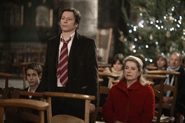Returning to the recurring themes of parental alienation and surrogacy of La Vie des morts, Playing “In the Company of Men”, and Kings and Queen, A Christmas Tale is a quintessential Arnaud Desplechin film in its ingenious, heady collision of disparate, often contradictory, yet integrally interconnected forms. On one level is the intersection of savior and prodigal son that Henri (Mathieu Amalric) paradoxically embodies: once conceived by his parents Junon (Catherine Deneuve) and Abel (Jean-Paul Roussillon) as a potential – but ultimately incompatible – donor for their terminally ill eldest child, Joseph, and now a neurotic, financially unstable drifter returning home for Christmas after a five year separation, having invested in a failed theater to win the affection of his emotionally distant elder sister, Elizabeth (Anne Consigny) (and who, in turn, would settle the bankruptcy on his behalf with the provision that he is now banished from the family). Inherent in the idea of the messiah is also the theme of Jewish versus Catholic faith that runs through the film, both cultures ingrained with the assumption of guilt and responsibility that also represents Henri’s inability to save his dying brother, and the commonality of ancestral origin and history that binds the religions together, not unlike the unintended legacy of rejection and rivalry that Joseph’s death represents for the succeeding generations of the family (note the implication of sibling rivalry in Abel’s name). Indeed, the ideal marriage between Sylvia (Chiara Mastroianni) and Ivan (Melvil Poupaud), Junon and Abel’s youngest son, also becomes an unexpected source of re-evaluation when a cousin’s devotion proves to be more than familial. Another is the idea of blood rejection, reflected both literally in the type of leukemia that would take Joseph’s young life and the blood disorder that now afflicts Junon, and figuratively in Junon and Elizabeth’s severity towards Henri. Similarly, this familial rejection also serves as a broader implication of the film’s Roubaix setting, a city with a thriving community of colonial repatriates and people of North African descent, contextually alluding to the often unreconciled relationship and tenuous assimilation between French society and immigrants (and their descendents) from its former colonies. Bookended with images from Elizabeth’s childhood puppet show, the film draws implicit association with the idea of human comedy as manipulated construction, theater of the absurd, and representation of sublimated desire.
© Acquarello 2008. All rights reserved.
